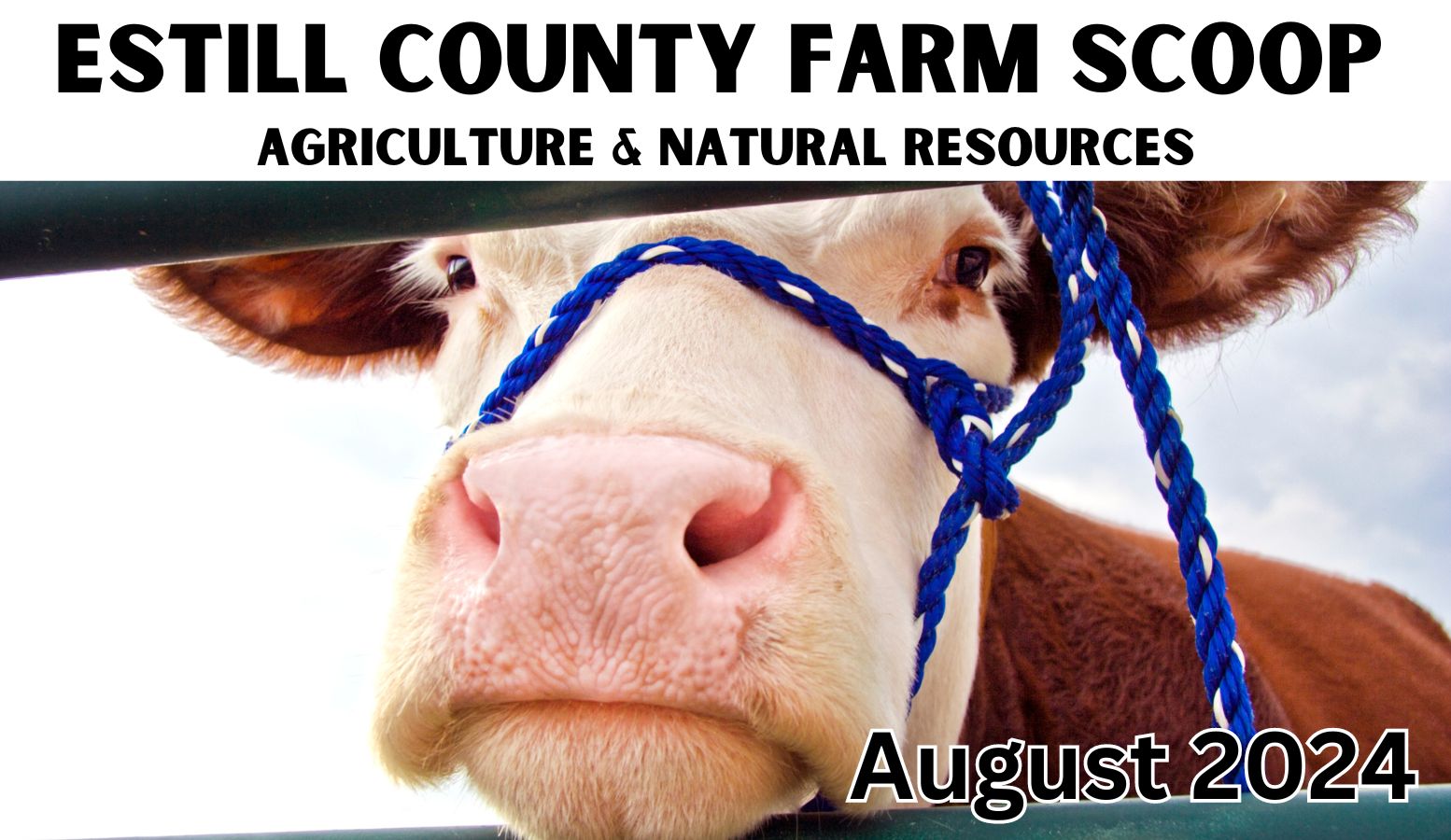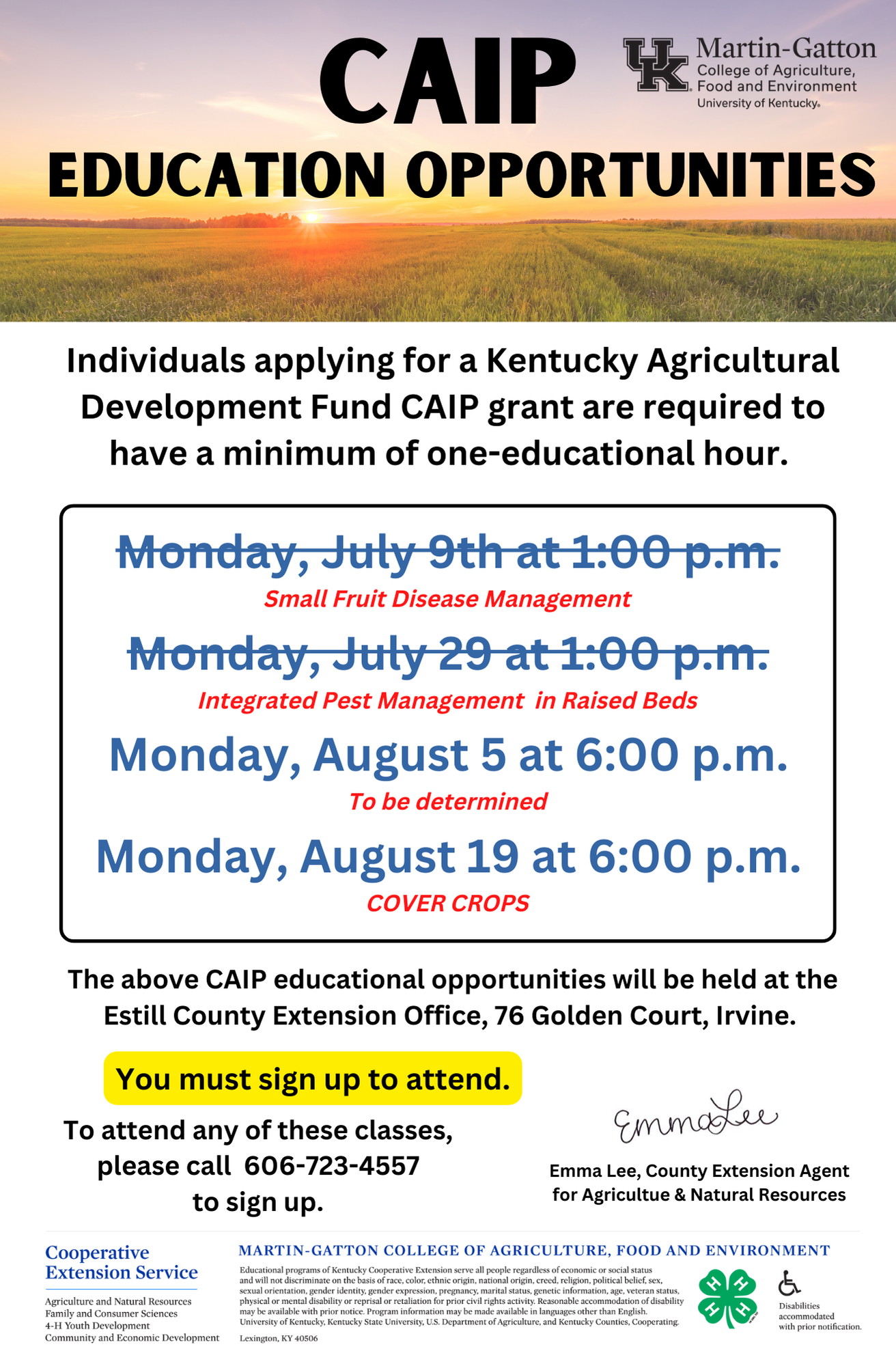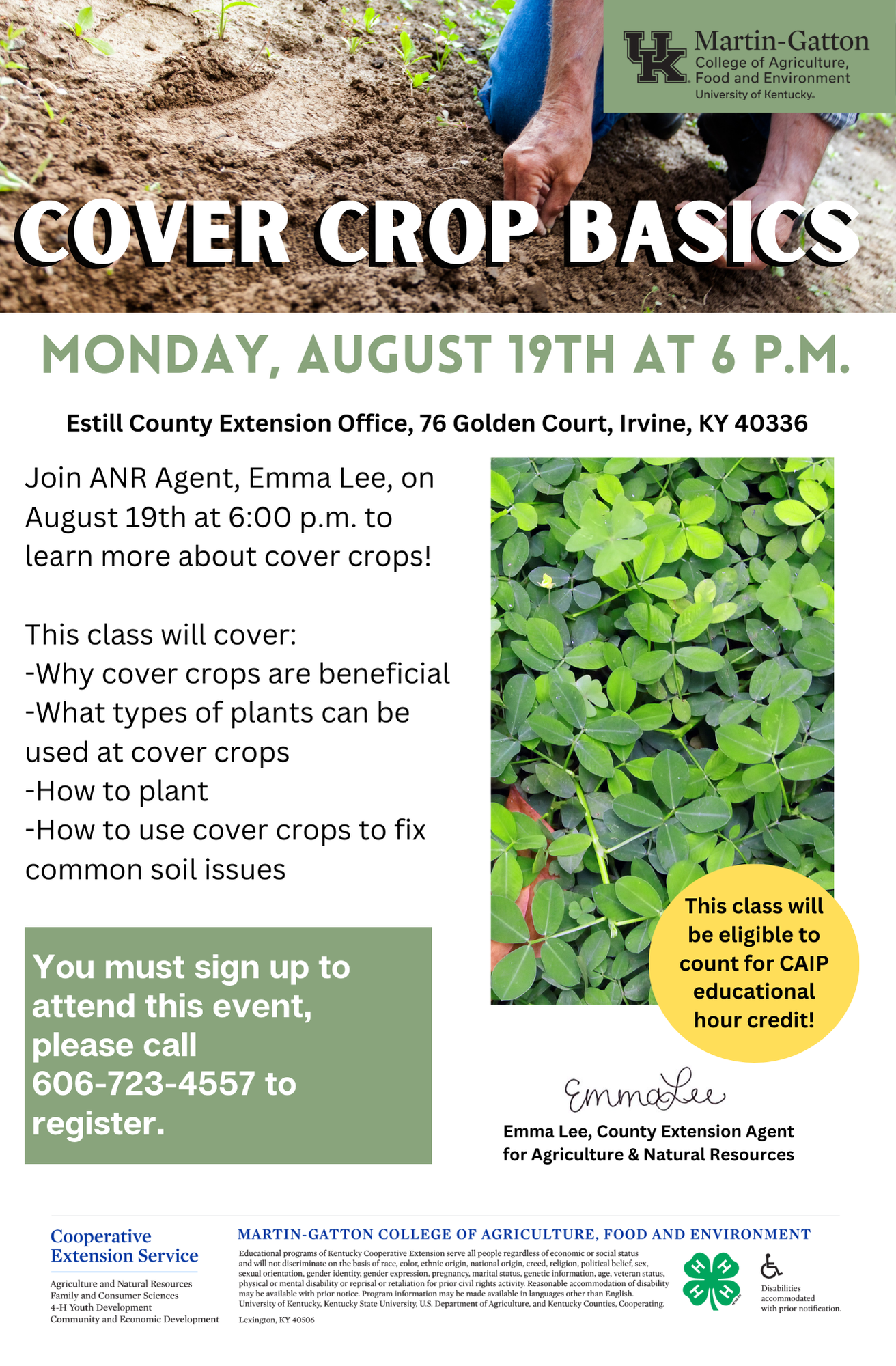Estill County Farm Scoop - August 2024
August 2024 Edition
Agriculture & Natural ResourcesView Newsletter
Share this Newsletter
Additional Newsletters
Preview This Newsletter

Time to Plant Your Fall Garden
Source: Rick Durham, UK extension horticulture specialist
As the summer warmth begins to wane, you don’t have to bid farewell to the joys of cultivating your garden. This time between seasons offers a golden opportunity to plant a vibrant fall vegetable garden, promising an uninterrupted flow of produce throughout autumn. Alternating balmy days and brisk nights support a variety of cool-season vegetables for your family to enjoy. Some of the best quality vegetables are produced during fall’s warm days and cool nights. These environmental conditions add sugar to late-season sweet corn and cole crops, such as cauliflower and cabbage, and add crispness to carrots. Fall vegetables harvested after early September consist of two types: the last succession plantings of warm-season crops, such as corn and bush beans, and cool-season crops that grow well during the cool fall days and withstand frost. When planting a fall garden, group crops the same way you would in the spring; plant so taller plants don’t shade out shorter ones. To encourage good germination, fill each seed furrow with water and let it soak in.
Keep the soil moist until seeds have germinated. Be aware that cool nights slow growth, so plants take longer to mature in the fall than in the summer.
You may use polyethylene row covers to extend the growing season of frost-sensitive crops, such as tomatoes, peppers and cucumbers. This helps trap heat from the soil and protect the crop from chilly night temperatures. Often Kentucky experiences a period of mild weather after the first killing frost. If you protect frost-sensitive vegetables at critical times in the fall, you could extend the harvest season by several weeks. Once these vegetables die due to lower temperatures, you may be able to plant cool-season crops in their place. Leafy greens like lettuce and spinach may grow into November or December under polyethylene row covers if outside temperatures do not drop below the teens. Be sure to allow for ventilation on sunny days to prevent overheating.
You may successfully seed or transplant the following vegetables now for fall harvest: beets, Bibb lettuce, broccoli, Brussels sprouts, cabbage, carrots, cauliflower, collards, endive, leaf lettuce, kale, mustard greens, spinach, snow peas and turnips.
Small Ruminant Boot Camp and Parasitology Clinic
September 14, 2024
Grayson County Extension Office, 64 Quarry Road, Leitchfield, Kentucky 42754
Fee: $35 includes 1 FAMACHA Certification and Lunch
$10 per additional lunch
Registration Includes: FAMACHA Certification, hoof trimming, quality assurance basics
Registration Deadline: September 6, 2024
Hybrid program where participants watch videos prior to the event (videos must be completed prior to Sept 14th):
Parasitology 101- Aug 19
Dewormers and Treatment Strategies- Aug 24
Rotational Grazing for Parasite Resistance- Sept 2
(Videos are required for certification)
In-person Clinic, 9:15am-4:15pm, Sept 14th ,
Grayson County Extension Office, 64 Quarry Road, Leitchfield, Kentucky 42754
Nutrition and Health Connections
Why Do Fecals?
Lunch
Parasite Q & A
Body Condition Scoring and FAMACHA Presentation
Fecal Flotation and Fecal Egg Count Presentation
Hands-on Workshops for FAMACHA and Fecal Egg Counts
Hoof Trimming
SRQA Basics\
Preventing Postharvest Disease Losses in Vegetable Crops
By: Kim Leonberger, Plant Pathology Extension Associate and Nicole Gauthier, Plant Pathology Extension Specialist
Vegetable produce is often soft, perishable, and particularly susceptible to a range of damage during harvest and storage. Growers can experience postharvest crop losses between 25% and 50%. A significant percentage of postharvest losses are caused by plant diseases. Infection by disease-causing pathogens can occur in the field and/or through wounds during harvest. Under moist conditions or high humidity, these infections can develop into molds, rots, or other decay. Even produce destined for fresh market can develop postharvest diseases during short-term storage.
Infection in the Field
Plant diseases such as fruit rots, leaf spots, and root rots can occur while plants are growing or while fruit are maturing (Figure 1). Infections can remain latent (dormant) until produce reaches a particular stage of maturity or until certain environmental conditions are reached.
Management
- Maintain a disease management program all season.
- Discard diseased and damaged produce as soon as it is visible.
- Avoid mixing diseased produce with healthy produce (e.g., in storage bins).
- Apply fungicides at harvest or after harvest if field disease was present.
Infection During Harvest & Handling
Wounds, bruising, desiccation, and exposure to temperature extremes can weaken produce and allow pathogen entry, resulting in disease. Many of the same plant pathogens that infect crops in the field can also infect wounded or damaged produce during harvest. Disease may appear soon after produce is moved to the cooler or storage, or there may be a delay in disease development.
Management
- Minimize wounds and bruises during harvest, handling, and packaging.
- Raise bins and buckets off the ground during harvest.
- Cool produce as soon as possible.
- Avoid leaving harvested produce in the heat or sun.
- Wash dirty or muddy produce and dry thoroughly before storage.
- Wash and sanitize bins and equipment before each harvest.
Disease in Storage
Improper storage conditions can provide ideal environments for disease-causing organisms to infect (Figure 2). Healthy produce can become diseased in storage when moisture is too high, temperatures are too warm, and pathogens are present.
Management
- Separate produce by type, harvest date, and field origin.
- Cool produce as soon as possible while remaining within the safe range for the specific produce.
- Monitor storage temperature and humidity.
- Increase ventilation.
- Raise produce off the floor.
- Reduce surface wetness by maintaining equipment and keeping produce dry.
- Follow a strict sanitation program, which is critical.
- If vegetables must be washed before storage, they should be completely dry before storage.
- Keep all surfaces clean; sanitize regularly.
- Wash and sanitize all bins, tools, and harvest materials before bringing them into coolers or storage units.
- Inspect stored produce regularly and discard damaged and diseased material immediately.
Save the Date
The Estill County Cattlemen’s Association and Beef Producers will meet on Thursday, September 12th at 6:00 p.m. at the Estill County Extension Office, 76 Golden Court, Irvine, KY.
Dr. Jeff Lehmkuhler will be presenting the program for the evening.
Dispose of Empty Pesticide Containers Safely
By Lee Townsend, Extension Entomologist
Use the Kentucky Rinse and Return Program, a voluntary, cooperative program sponsored by the Kentucky Department of Agriculture (KDA) and the Agri-Business Association of Kentucky (ABAK). Other partners include the University of Kentucky Cooperative Extension Service (which helps coordinate the Program at the county level), Farm Bureau, the U.S. Department of Agriculture’s Natural Resources Conservation Service and the local conservation districts, and the Ag Container Recycling Council.
Container-handling instructions on pesticide labels will tell you how to clean and dispose of empty containers. Never reuse pesticide containers. Not all containers must be triple-rinsed or pressure-rinsed. If rinsing is required, follow the directions on the label and rinse immediately after emptying the container. Otherwise, residues may become difficult to remove if allowed to dry. When possible, add the rinsate to the next application.
Pressure Rinsing
- Hold the empty container upside down over the spray tank opening and let it drain for at least 30 seconds.
- While still holding the container over the opening, puncture the bottom with the pressure-rinse nozzle.
- Rinse according to the manufacturer’s recommendation (generally 30 seconds or more).
- Keep rinsed, empty pesticide containers in a secured storage area until they can be recycled or disposed of properly.
-
Triple Rinsing
- Empty the pesticide into the spray tank and let the container drain for 30 seconds.
- Fill the container 10% to 20% full of water or rinse solution.
- Secure the cover on the container and swirl it to rinse all inside surfaces.
-
Refillable Containers
Refillable containers will have instructions to return the container to the pesticide dealer or manufacturer. Never tamper with a container designed to be returned and refilled. The label will tell you whether you can recycle, recondition, or dispose of the container and the manner of disposal.
Be Ready for Spills
- Keep a spill cleanup kit in each pesticide transport vehicle and at the site where pesticides are mixed, loaded, and stored. Store your spill kit items in a plastic container and keep them clean and in working order. Include the following items in a spill response kit:
- Telephone numbers for emergency assistance.
- PPE designed for use with pesticides.
- Absorbent materials, such as spill pillows, absorbent clay, and cat litter.
- A shovel, broom, and dustpan.
- Heavy-duty detergent.
- Remove cover, pour the rinsate into sprayer tank and let it drain for 30 seconds or more.
- Repeat the rinse process at least 2 more times.
- Puncture the container so it cannot be reused.
- Keep rinsed, empty pesticide containers in a secured storage area until they can be recycled or disposed of properly.
The 2024 Rinse N Return drop off date will be August 29, 2024 from 10-12 pm at the Estill County Extension Office!

-


